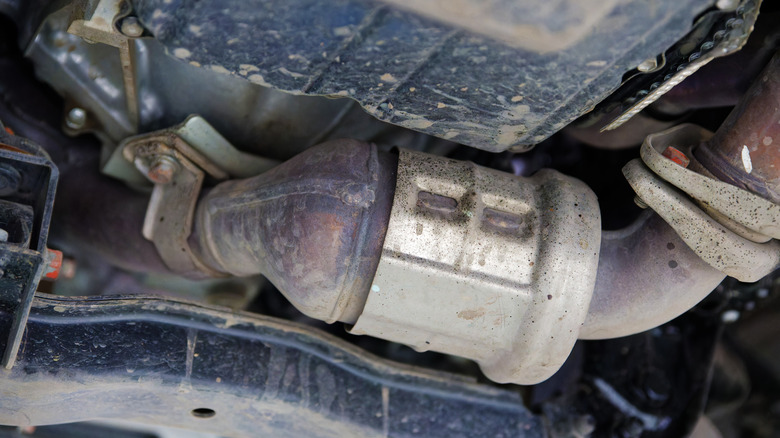If Your Car Smells Like Rotten Eggs, Here's What You Need To Check
It can be a bit bemusing at first when detecting the smell of rotten eggs in your car, especially when you're not sure of the source. There's no forgotten grocery bag in the hot trunk, and you didn't accidentally buy a rotten egg scented air freshener. So if the culprit is unfortunately not egg-related, where's it coming from?
An unfortunately popular thing to steal — though efforts to reduce theft are underway – catalytic converters are metal canisters that sit in the exhaust system between the muffler and engine. Inside is a honeycomb element used to convert hazardous gasses — like carbon monoxide and nitrogen oxide — into less harmful substances out of the exhaust. However, the smell of rotten eggs is often linked with hydrogen sulfide. Its aroma in the car is likely a result of the catalytic converter not functioning properly, releasing hydrogen sulfide instead of normally turning it into odorless sulfur dioxide. And not only does that smell bad, but you don't want to be breathing it either.
Why the catalytic converter is malfunctioning
While the smell is likely to appear more toward the back of the car near the tailpipe, it could easily seep inside anywhere. Since hydrogen sulfide can be hazardous, it's best to open the windows, and head to a mechanic as soon as possible. Most catalytic converters ideally will last the life of the car (especially when they're cleaned), but various small issues, sometimes indicative of a larger problem with the engine, can lead to the converter malfunctioning.
This could include the engine damaging the converter by sending raw gas into it, or an oil or coolant leak burning in the cylinders and flowing into the converter. Of course, such issues will likely present other symptoms before the converter fails (like smoke or a check engine light), and must first be addressed before dealing with the converter. Catalytic converters need the ideal mix of exhaust gasses at the right temperature to function properly, and any disruption to this mix, in the form of an additive or temperature fluctuation, can lead to damage.

